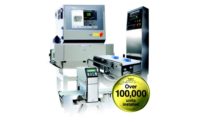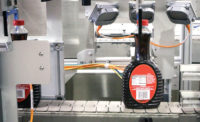Machinery Technology
Extending quality inspection to the packaging process
Clark Brown, sales director, Engineered Products Division, Valco Melton gives us the lowdown.

Clark Brown, sales director, Engineered Products Division, Valco Melton

PackChek has been designed to catch missing, weak and out of position glue beads.

PackChek camera inspection system analyzes thermal and visual images of every package to ensure proper hot melt application in real time.



If you’re like many food and beverage manufacturers, you’ve already integrated automation into your production line to reduce costs, increase production and improve efficiency. While these technological advances have allowed manufacturers to meet production requirements, they have also posed new challenges, particularly as it relates to ensuring case integrity during the packaging process.
Labor-intensive activities such as palletizing have now been automated through the use of robotics and gripping systems. Since these grippers typically use suction cups to lift the product from the top, if the cases haven’t been properly sealed, there’s a high risk of them collapsing and product falling out.
The fact is, as more companies move to robotic palletizing systems, the integrity of your cases becomes even more important. This is where vision systems, and in specific, hot melt inspection systems like PackChek™, are essential.
Packaging Strategies: Why should I invest in hot melt inspection in my packaging process?
Clark Brown: Have you ever walked into a store and seen a damaged case that has been wrapped in packing tape because the glue didn’t hold? One open case may not cost you a customer immediately, but in terms of building and sustaining brand equity, such product experiences can negatively affect a brand’s perceived quality.
From a purely monetary perspective, a returned truckload of product could cost 10s of thousands of dollars. On today’s automated production lines, many products go unseen after the packaging process. By implementing a hot melt inspection system, you eliminate those rework costs by catching defects before they are even palletized.
If your customers have complained about pop-opens, missed glue application, or out-of-line, missing, or torn flaps, it’s a good idea to look into your end-of-line packaging process and see if you could benefit from implementing a hot melt inspection system.
PS: What is PackChek and how does it differ from other detection systems?
Brown: PackChek camera inspection system analyzes thermal and visual images of every package to ensure proper hot melt application in real time. With current line speeds exceeding 300 feet per minute and up to 10,000 cases per hour, PackChek is ideal for high-speed cartoners, case sealers and even wrap around machines.
Glue sensors have been around for decades, but tight space constraints on packaging machinery have made retrofitting them into existing lines extremely difficult. To combat this, rather than looking directly at the adhesive pattern as is done with traditional cameras, PackChek inspects the entire case, after the flaps are closed, to ensure correct hot melt placement, compression and case integrity. As a result, the inspection camera can be mounted on a discharge conveyor, without space constraints.
PS: How does PackChek work?
Brown: PackChek has been designed to catch three main types of defects:
- Missing glue beads
- Weak glue beads
- Out of position glue beads
Using thermal imaging, PackChek evaluates any number of hot melt patterns within the camera frame.
It then verifies its position and displays a user-friendly image, which can be saved for later use.
When one bead, or a combination of beads, does not meet a requirement (predetermined tolerance levels configured by the user), outputs can be configured to stop the machine, eject a case, or sound an alarm.
PS: What are the advantages of logging real-time data during your packaging processes?
Brown: Camera inspection systems can be used as part of larger strategies to optimize packaging processes from end-to-end. PackChek, for example, logs and archives data in real-time, including defective images and past jobs (up to 6 months), which can all be recalled at any time.
Using automated data collection systems such as this allows companies to gain the insight and visibility needed to identify problems and areas for improvement to increase efficiency. Having the added benefit of real-time feedback also makes it easier to identify and correct issues as soon as they arise, putting manufacturers in control of the quality of their product, before it has the chance to leave the doors.
Established in 1952, Valco Melton (valcomelton.com) is one of the world’s leading manufacturers of adhesive application and quality assurance equipment across the packaging, paper converting, graphic arts and nonwoven industries.
Clark Brown serves as Valco Melton’s Sales Director, Engineered Products Division and brings a wealth of experience and knowledge, having worked in the industry for 27 years.
Looking for a reprint of this article?
From high-res PDFs to custom plaques, order your copy today!










